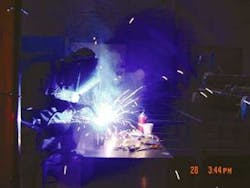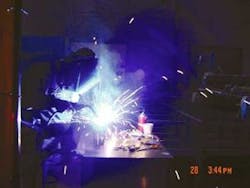Industrial Safety: Aerosol monitor uses imaging, sensors to measure particles
Whenever hazardous substances such as dusts, fumes, mists, vapors, or gases exist or are produced in manufacturing or construction, their concentrations must not exceed specific limits set by the US Occupational Safety and Health Administration (OSHA; Washington, DC, USA; www.osha.gov). Environmental Devices Corp. (EDC; Plaistow, NH, USA; www.hazdust.com) manufactures many different types of instruments that monitor levels of such substances, including a range of aerosol monitors such as the Haz-Dust III, a portable monitor designed for industrial hygiene and environmental air investigations.
To measure particles in concentrations as low as a few milligrams per cubic meter (mg/m3), the Haz-Dust III uses the principle of near-forward light scattering of infrared (IR) radiation. As airborne particles enter an IR light source positioned at 90° from a photodetector they scatter light, and the amount of light received by the photodetector is directly proportional to the aerosol concentration. As particle data are captured, the information is analyzed by a PC within the unit and displayed on a liquid-crystal display. For later analysis, these data can be downloaded to a PC over a serial interface or a wireless transmitter. To permit different sized particles to be measured, the sensor design allows the interchange of sampling heads. For further gravimetric or chemical analysis, an in-line disposable filter simultaneously collects samples.
“In many hazardous environments,” says Mark Sullivan, president of EDC, “it is also necessary for the plant manager to know where the sources of possible contamination may be.” To do this, in its next generation of Haz-Dust III units, EDC will incorporate video as well as particle data-monitoring capability. The prototype unit, shown at Vision 2004 in Stuttgart, Germany, incorporated a wireless transmitter to send serial data to a host PC equipped with a wireless transmitter. To capture video data, EDC used a CX-161 RS-170 camera from Panasonic (Secaucus, NJ, USA; www.panasonic.com) embedded with a wireless transmitter.
Video data transmitted to a host PC are captured by a video receiver and digitized by an LFG-PCI RS-170 compatible frame grabber from Active Silicon (Uxbridge, UK; www.activesilicon.com). By combining both serial data from the IR sensor and the video data in one image, administrators at a central PC station can visualize both the level of particles in the air and the location of the Haz-Dust operator. “By using the LFG-PCI board with up to four NTSC inputs,” says Sullivan, “a PC system can support up to four cameras and HazDust monitors. In this way, four individual locations and particle airborne concentrations can be monitored from one PC.”
Active Silicon wrote the host PC application that integrates the dust-sensor data with the video stream. By recording video information, variations in dust levels can be correlated with image data. Because of this, the video stream needs to be synchronized with dust-level concentration data sent wirelessly from the dust monitor. Dust concentration level is read into the application via the PC serial port (or via a USB serial port on the latest PCs), decoded, and then inserted into individual video frames.
The video application must record up to eight hours of video data at several frames per second. It can also record events such as dust levels exceeding a preset threshold. In this situation, a “pre-event buffer” must be recorded. Individual JPEG frames are recorded with the dust level subtitled into the video and with the dust data embedded into the “comment” area of the JFIF (JPEG File Interchange Format) standard. This allows images to be automatically scanned for certain dust levels and indexed via a database. Individual JPEG frames also allow nontechnical users to view, print, and e-mail images.
When used as part of a routine air-monitoring program, Haz-Dust can reduce the number of filter gravimetric tests and laboratory analyses required. “For example,” says Sullivan, “an OSHA-compliant air-monitoring program may dictate air monitoring for particulates on a monthly basis to determine if work practices are below federal regulations. If a company has ten or more employees at risk, this can result in as many as 10 to 20 tests per month and subsequent lab analysis.” By using the Haz-Dust monitor, particulate concentrations can be determined immediately.
The Haz-Dust can be used for a number of applications including lead-, silica-, welding-fume, pharmaceutical-, and construction-dust monitoring. Software, running on a PC-based host can be used to tabulate management ready graphs and reports.

